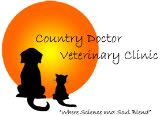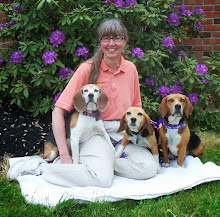This is a good day for me to make the final blog on obesity series. This morning I saw Chloe the Boxer for her annual physical exam. Last year, Chloe weighed in at a chubby 67 lbs. I gave the standard diet recommendation and this year Chloe is a trim 58 lbs.. You do not know how happy I get when I see that! What a good job by Chloe's "mom"! Chloe's mom commented on much more active Chloe is now that she shed 9 lbs. That is a LOT for a dog. Equivalent to a woman losing around 20 lbs. Happy owner. Happy dog. Happy vet. Happy!
Now darn me I didn't bring my camera to work today so I don't have a picture of Chloe. What I do have is a picture of Harley. Harley is a slim and trim 7 year old Labrador Retriever. Some days I wonder if a normal weight lab exist, so Harley is a welcome change from the steady parade of obese retrievers that come through the door. Here are a couple of pictures of Harley. Notice in the view from above that he indeed has a waist. So cool!


So how to get your pet down to a happy weight? There are 2 basic options for cats and 3 for dogs. They all have their pluses and minuses so I will go over them one at a time.
Option 1. Standard diet and exercise. First you need to figure out how many calories your pet
should be eating. I have a great chart at the clinic that works for 99% of the pets I see. It's too long to post here, but feel free to call or email me and I'll get the information to you. You can also get a smaller version of the chart at the
http://www.petobesityprevention.com/ web page. After you get the number of calories needed per day, you get to count calories for your pet. You have to count calories from ALL food sources including treats. Yes, you can still give treats (lets be real. we all give our dogs at least a few treats every day), but you have to count the calories. Again call or email me if you have questions about how to figure out how many calories are in different foods or treats. I don't mention as much about exercise as I should, but we all need exercise. Good excuse to take the dog for a walk. Cats are a little harder, but laser lights and toys that dispense bits of food as the cat plays with it (instead of eating it out of a dish) work well.
The advantages of option 1. No diet change needed. The most inexpensive method.
The disadvantages of option 1. Studies show only about a 6% success rate. A slight possibility of pets not getting the right amount of nutrients if fed reduced amount of a standard diet for a long period of time (although I have not seen this happen, ever.)
Option 2. Prescription reducing diet. These are special veterinary formula diets that you can only get through a veterinarian. They tend to have low amounts of calories per cup or ounce of food. Again, you have to count calories; but because you have to get the diet through our clinic, there is a tendency for closer monitoring. This makes these diets more successful than using standard diets.
The advantages of option 2. Reducing diets provide more nutrients and satisfy that hungry feeling better than using a standard diet. There tends to be closer monitoring of weight and adjusting of diet if needed. Higher success rate than reducing the amount of a standard diet.
The disadvantages of option 2. More expensive than a regular diet (but remember, pets are not on this for life. Think of it as medicine to treat a medical condition which is what obesity is.) Have to order through a veterinarian.
Option 3. Slentrol weight loss drug. This is only an option for dogs. This option works very well for the dogs that are so appetite driven that when you cut calories they start doing bad things like getting into the garbage or breaking into the cupboards to get to food. The drug is a liquid that you give by mouth. It is basically an appetite suppressant and it does work very well when used properly.
The advantages of option 3. Controls appetite so the dogs are more comfortable during the weight loss phase. Works well for most dogs. Does not necessarily need a diet change (although you still need to change the way you feed your dog to keep the weight from coming back after discontinuing the drug).
The disadvantages of option 3. Requires veterinary monitoring and is a prescription drug. More expensive than option 1. The safety has only been tested for 1 year of continuous use so some very obese dogs may have to go with another option if weight loss takes longer than a year. Not to be used with some chronic medical conditions such as liver disease.
As a final note, I just have to show you a picture of Tuff the Golden Retriever. I saw Tuff last year for his annual exam and he weighed 106.3 lbs.. Unfortunately I don't have a before picture., but there is no Golden Retriever that I have ever seen that should weigh this much. So we discussed diet and exercise. Fast forward to this year when Tuff showed up for his annual exam sporting a new 85.7 lb weight. Oh boy did he ever look good. That is over 20 lbs of weight loss on a dog! How cool is that! Congratulations to Tuff's family for doing such a good job. The rewards will be a happier and healthier dog. You couldn't ask for better than that.

I'm sure I'll be posting more pictures from time to time of happy dogs that have lost weight so stay tuned.
 I have to say that Thanksgiving is absolutely my favorite holiday. Perhaps it was because I was born on Thanksgiving Day so growing up, the Thanksgiving "season" always had some special meaning. But as a grown-up, I think I love Thanksgiving because it is a celebration without strings attached. It is simplistic and that is refreshing when life can be so hectic and complicated. Thanksgiving is about getting together with family and friends and enjoying really good home cooking. No gifts, no fancy decorations, no fireworks, no baskets of candy. Just family, friends and food.
I have to say that Thanksgiving is absolutely my favorite holiday. Perhaps it was because I was born on Thanksgiving Day so growing up, the Thanksgiving "season" always had some special meaning. But as a grown-up, I think I love Thanksgiving because it is a celebration without strings attached. It is simplistic and that is refreshing when life can be so hectic and complicated. Thanksgiving is about getting together with family and friends and enjoying really good home cooking. No gifts, no fancy decorations, no fireworks, no baskets of candy. Just family, friends and food.







